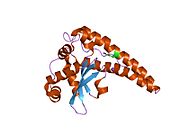SOD2
Ensembl | |||||||||
|---|---|---|---|---|---|---|---|---|---|
| UniProt | |||||||||
| RefSeq (mRNA) |
| ||||||||
| RefSeq (protein) |
| ||||||||
| Location (UCSC) | Chr 6: 159.67 – 159.76 Mb | Chr 17: 13.23 – 13.26 Mb | |||||||
| PubMed search | [3] | [4] | |||||||
| View/Edit Human | View/Edit Mouse |
Superoxide dismutase 2, mitochondrial (SOD2), also known as manganese-dependent
Structure
The SOD2 gene contains five
Function
As a member of the iron/manganese

Mechanism
SOD2 uses cyclic proton-coupled electron transfer reactions to convert superoxide (O2•-) into either oxygen (O2) or hydrogen peroxide (H2O2), depending on the oxidation state of the manganese metal and the protonation status of the active site.
Mn3+ + O2•- ↔ Mn2+ + O2
Mn2+ + O2•- + 2H+ ↔ Mn3+ + H2O2
The protons of the active site have been directly visualized and revealed that SOD2 utilizes a series of proton transfers among its active site residues per electron transfer step.[9] The findings demonstrate the use of unusual chemistry by the enzyme that include a glutamine that is cyclically deprotonated and protonated and amino acids with pKas that are significantly different from expected values. Low-barrier and short-strong hydrogen bonds are seen contributing to catalysis by promoting proton transfers and stabilizing intermediates in a fashion similar to those of some catalytic Asp-Ser-His triads.[10]
Clinical significance
The SOD2 enzyme is an important constituent in apoptotic signaling and
Cancer risk
Numerous studies have reported associations between SOD2 polymorphisms and cancer risk, but results have been inconsistent. An updated meta-analysis of such studies revealed that SOD2 polymorphisms are related to the development of non-Hodgkin lymphoma, lung cancer, and colorectal cancer.[13]
Role in oxidative stress
Most notably, SOD2 is pivotal in
Due to its cytoprotective effects, overexpression of SOD2 has been linked to increased invasiveness of
Yeast studies
In wild-type budding yeast
Role in invertebrates
SOD2's significant role in oxidative stress management makes it an essential component of the mitochondria. As a result, SOD2 similarly to SOD1 and SOD3 is highly conserved in vertebrates as well as in invertebrates. In the study Multiple measures of functionality exhibit progressive decline in a parallel, stochastic fashion in Drosophilla Sod2 mutants.[25] In SOD2 mutants there was a cascade of deterioration within the organ systems. These deterioration were not linear in that one organ's system would fail then the other, rather on the contrary the deterioration were parallel, meaning that various systems would be affected at any given time. The build up of ROS's in the flies did play a substantial role in affecting the organ system s of the flies in such a way, that though not all observed flies suffered permanent damage, the damages that were observed were like those associated with old age in mature fruit flies.[20] The tissues that are affected in light of defective SOD2 in invertebrates are the muscles, heart, and brain. ROS's effect on these tissue results in not only loss of cellular function in most cases, but a substantial loss in longevity.[21] Though SOD2's role in oxidative stress management is one that has been accepted for both vertebrates and invertebrates, its necessity has been questioned by a study that was conducted on Caenorhabditis elegans (C. elegans). The correlation between the lack of defective SOD2 and loss of longevity and function is generally understood, however it was discovered that the removal of some of the five members of the SOD family including SOD2 resulted in the increase in longevity in mutant C. elegans compared to the wild type.[26]
Animal studies
When animals are exercised at a relatively high work rate, exercise training promotes an increase in myocardial MnSOD activity. Increased MnSOD activity is required to achieve optimal training-induced protection against both ischemia/reperfusion(IR)-induced cardiac arrhythmias and infarction Using an antisense oligonucleotide against MnSOD to prevent ExTr-induced increases in myocardial MnSOD activity, it was demonstrated that an increase in myocardial MnSOD activity is required to provide training-induced protection against IR-induced myocardial infarction.[27] Using a MnSOD gene silencing approach, reported that prevention of the ExTr-induced increase in myocardial MnSOD resulted in a loss of training-induced protection against IR-mediated arrhythmias.[28]
In a mouse model,
Mutant mice with a connective tissue specific lack of SOD2 had a reduced lifespan and a premature onset of aging-related phenotypes such as weight loss, skin atrophy, kyphosis (curvature of the spine), osteoporosis, and muscle degeneration.[31]
SOD2 over-expression was found to extend lifespan in mice.[32]
Interactions
The SOD2 gene has been shown to bind:
The SOD2 protein has been shown to interact with HIV-1 Tat and HIV-1 Vif.[33]
References
- ^ a b c GRCh38: Ensembl release 89: ENSG00000112096 – Ensembl, May 2017
- ^ a b c GRCm38: Ensembl release 89: ENSMUSG00000006818 – Ensembl, May 2017
- ^ "Human PubMed Reference:". National Center for Biotechnology Information, U.S. National Library of Medicine.
- ^ "Mouse PubMed Reference:". National Center for Biotechnology Information, U.S. National Library of Medicine.
- ^ a b c d e f g "Entrez Gene: SOD2 superoxide dismutase 2, mitochondrial".
- ^ PMID 25224035.
- ^ PMID 12551919.
- ^ PMID 19265433.
- ^ PMID 33824320.
- PMID 29973622.
- S2CID 10764012.
- PMID 4561027.
- PMID 26628947.
- S2CID 10556268.
- PMID 4056048.
- PMID 25868322.
- S2CID 24815784.
- PMID 17640558.
- S2CID 10900822.
- ^ PMID 14679299.
- ^ PMID 18067683.
- PMID 12072463.
- PMID 24462872.
- S2CID 205563521.
- PMID 19148770.
- PMID 19197346.
- PMID 10359573.
- PMID 15454275.
- PMID 22278880.
- PMID 26240345.
- S2CID 46458295.
- PMID 17129739.
- PMID 24667918.
Further reading
- Zelko IN, Mariani TJ, Folz RJ (Aug 2002). "Superoxide dismutase multigene family: a comparison of the CuZn-SOD (SOD1), Mn-SOD (SOD2), and EC-SOD (SOD3) gene structures, evolution, and expression". Free Radical Biology & Medicine. 33 (3): 337–49. PMID 12126755.
- Faraci FM, Didion SP (Aug 2004). "Vascular protection: superoxide dismutase isoforms in the vessel wall". Arteriosclerosis, Thrombosis, and Vascular Biology. 24 (8): 1367–73. PMID 15166009.























